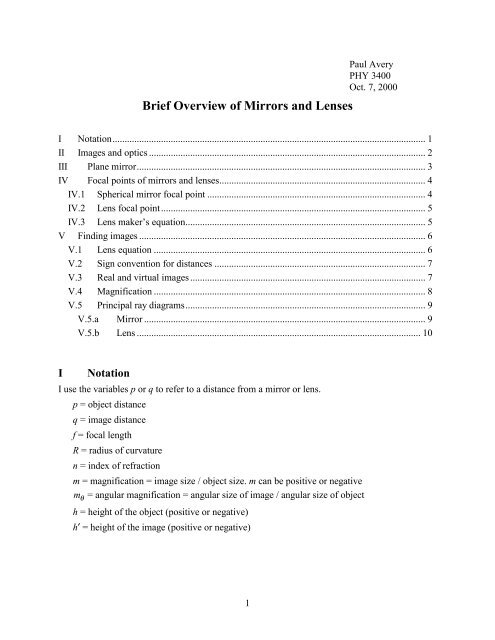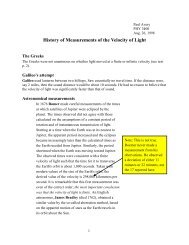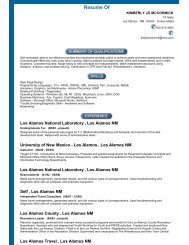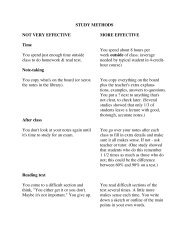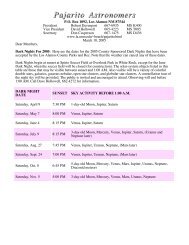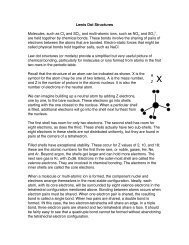Brief Overview of Mirrors and Lenses
Brief Overview of Mirrors and Lenses
Brief Overview of Mirrors and Lenses
Create successful ePaper yourself
Turn your PDF publications into a flip-book with our unique Google optimized e-Paper software.
<strong>Brief</strong> <strong>Overview</strong> <strong>of</strong> <strong>Mirrors</strong> <strong>and</strong> <strong>Lenses</strong><br />
Paul Avery<br />
PHY 3400<br />
Oct. 7, 2000<br />
I Notation................................................................................................................................. 1<br />
II Images <strong>and</strong> optics .................................................................................................................. 2<br />
III Plane mirror....................................................................................................................... 3<br />
IV Focal points <strong>of</strong> mirrors <strong>and</strong> lenses..................................................................................... 4<br />
IV.1 Spherical mirror focal point .......................................................................................... 4<br />
IV.2 Lens focal point............................................................................................................. 5<br />
IV.3 Lens maker’s equation................................................................................................... 5<br />
V Finding images ...................................................................................................................... 6<br />
V.1 Lens equation ................................................................................................................ 6<br />
V.2 Sign convention for distances ....................................................................................... 7<br />
V.3 Real <strong>and</strong> virtual images ................................................................................................. 7<br />
V.4 Magnification ................................................................................................................ 8<br />
V.5 Principal ray diagrams................................................................................................... 9<br />
V.5.a Mirror ....................................................................................................................9<br />
V.5.b Lens ..................................................................................................................... 10<br />
I<br />
Notation<br />
I use the variables p or q to refer to a distance from a mirror or lens.<br />
p = object distance<br />
q = image distance<br />
f = focal length<br />
R = radius <strong>of</strong> curvature<br />
n = index <strong>of</strong> refraction<br />
m = magnification = image size / object size. m can be positive or negative<br />
m θ = angular magnification = angular size <strong>of</strong> image / angular size <strong>of</strong> object<br />
h = height <strong>of</strong> the object (positive or negative)<br />
h′ = height <strong>of</strong> the image (positive or negative)<br />
1
II<br />
Images <strong>and</strong> optics<br />
It is a remarkable fact that when light rays emerging from an object are reflected or refracted they<br />
can appear to come from a different location, called the image. It turns out that only specially<br />
shaped mirrors <strong>and</strong> lenses can form sharp images. We shall deal in this course with basic shapes<br />
such as plane mirrors, spherical mirrors <strong>and</strong> thin lenses.<br />
All geometric optics can be derived from the laws <strong>of</strong> reflection <strong>and</strong> refraction. Consider<br />
reflection first. When light hits a surface, the incident <strong>and</strong> reflected ray make equal angles from<br />
the normal to the surface, where the incident ray, reflected ray <strong>and</strong> normal form a plane, as shown<br />
in the figure below. Note that this law holds even when the surface is not flat. In that case, one<br />
uses the normal at the point <strong>of</strong> incidence.<br />
Reflection from a surface.<br />
θ<br />
θ<br />
Refraction is the bending <strong>of</strong> light when it goes from one medium into another. Refraction obeys<br />
Snell’s law, n1sinθ1 = n2sinθ2, where n1<br />
is the index <strong>of</strong> refraction <strong>of</strong> the first medium, n 2 is the<br />
index <strong>of</strong> refraction <strong>of</strong> the second medium, θ1<br />
is the angle <strong>of</strong> the ray from the normal in the first<br />
medium <strong>and</strong> θ 2 is the angle <strong>of</strong> the ray from the normal in the second medium. The two rays <strong>and</strong><br />
the normal form a single plane, just as for reflection. The laws <strong>of</strong> refraction determine the<br />
properties <strong>of</strong> lenses. Note that when n2 > n1, the ray in medium 2 bends towards the normal<br />
θ 1<br />
n 1<br />
θ 2<br />
n 2<br />
Refraction at a surface.<br />
2
III<br />
Plane mirror<br />
We are familiar with the images from plane mirrors. If we st<strong>and</strong> a distance p from the mirror,<br />
then our image is upright, identical in size <strong>and</strong> an equal distance p behind the mirror. These facts<br />
can be deduced from simple geometry. By careful construction, using the fact that the angle <strong>of</strong><br />
incidence is the same as the angle <strong>of</strong> reflection, you can see that light rays emitted from the tip <strong>of</strong><br />
the object <strong>and</strong> bouncing <strong>of</strong>f the mirror can be extended to the other side so they appear to be<br />
coming from the same position on the other side <strong>of</strong> the mirror. A person st<strong>and</strong>ing a distance away<br />
would “see” the image on the other side <strong>of</strong> the mirror.<br />
Exercise: Try to use one <strong>of</strong> the rays <strong>and</strong> simple geometry to “prove” that the image is located as<br />
shown below.<br />
Equal angle<br />
reflection<br />
1<br />
Observer sees rays<br />
coming from here<br />
Observer<br />
2<br />
3<br />
Object<br />
Image<br />
Mirror<br />
3
IV<br />
Focal points <strong>of</strong> mirrors <strong>and</strong> lenses<br />
The focal point <strong>of</strong> a lens or mirror is one <strong>of</strong> its most important characteristics. Rays <strong>of</strong> light<br />
moving parallel to the optic axis (the dotted line perpendicular to the mirror or lens in the figures<br />
below) are bent in such a way that they pass through the focal point. In the case <strong>of</strong> a convex<br />
mirror (see figure on the right), the rays are reflected in such a way that they appear to emerge<br />
from the focal point.<br />
IV.1 Spherical mirror focal point<br />
R > 0<br />
R < 0<br />
C<br />
f<br />
f<br />
C<br />
Parallel rays pass reflect from mirror,<br />
pass through focal point.<br />
Parallel rays pass reflect from mirror,<br />
appear to pass through focal point.<br />
A spherical mirror has a single focal point, with focal length given by f = 1 2<br />
R, where R is the<br />
radius <strong>of</strong> curvature <strong>of</strong> the mirror. Assume rays <strong>of</strong> light are incident from the left. Then R is<br />
positive when the mirror is concave to the left (above left) <strong>and</strong> negative when concave to the<br />
right (above right). The focal point is always on the concave side, on the same side as the center<br />
<strong>of</strong> the mirror. Light rays incident along the optic axis either reflect <strong>and</strong> pass through the focal<br />
point (above left) or reflect <strong>and</strong> appear to pass through the focal point (above right).<br />
Example 1: One makes a spherical mirror with a radius <strong>of</strong> curvature <strong>of</strong> 50 cm. The focal length is<br />
f = 50 /2 = 25 cm. The focal point is located on the inside <strong>of</strong> the curve.<br />
Example 2: A plane mirror has an infinite radius <strong>of</strong> curvature. Why? Because <strong>of</strong> this fact the<br />
focal length is infinity.<br />
4
IV.2 Lens focal point<br />
f<br />
f<br />
A lens always has two focal points, each located a distance f from the lens center, where f is the<br />
focal length. Incident rays moving parallel to the optic axis are refracted in such a way that they<br />
pass through the focal point. A typical lens is shown above.<br />
IV.3 Lens maker’s equation<br />
If you are given a lens made out <strong>of</strong> material <strong>of</strong> a known index <strong>of</strong> refraction <strong>and</strong> ground to a<br />
certain shape, then it is possible to calculate the focal length. The formula below is known as the<br />
“lens-maker’s equation”:<br />
1 ⎛ 1 1 ⎞<br />
= ( n − 1)<br />
⎜ + ⎟<br />
f ⎝r1 r2<br />
⎠<br />
where n is the index <strong>of</strong> refraction <strong>of</strong> the lens material <strong>and</strong> r 1 <strong>and</strong> r 2 are the radii <strong>of</strong> curvature <strong>of</strong><br />
the front <strong>and</strong> back face <strong>of</strong> the lens, respectively. The radius is positive when concave to the<br />
center <strong>and</strong> negative otherwise. Thus in the figure above r 1 <strong>and</strong> r 2 are both positive. Note that<br />
turning a lens around 180 degrees has no effect on its focal length. Why?<br />
5
Example: A lens is made from a glass having index <strong>of</strong> refraction 1.5. The front end is flat <strong>and</strong> the<br />
back end is convex outward with radius <strong>of</strong> curvature 40 cm (see figure below). Find the focal<br />
length.<br />
The front end is flat, so its radius <strong>of</strong> curvature is infinite. The back end has a positive radius <strong>of</strong><br />
curvature because it is concave to the center. Thus, r 1 =∞<strong>and</strong> r 2 = 40 cm. The focal length is<br />
then<br />
1 ⎛ 1 1 ⎞ 1<br />
= ( 1.5 − 1)<br />
⎜ + ⎟=<br />
f ⎝∞<br />
40 ⎠ 80<br />
or f = 80 cm.<br />
V<br />
Finding images<br />
V.1 Lens equation<br />
The lens equation is the basic formula relating object distance, image distance <strong>and</strong> focal length.<br />
The equation applies equally to mirrors or lenses. All distances are measured from the center <strong>of</strong><br />
the mirror or lens<br />
1 1 1<br />
+ =<br />
p q f<br />
This equation is accurate in the paraxial approximation, that is, when all angles relative to the<br />
optical axis are small.<br />
6
Example: Imagine a mirror with a focal length <strong>of</strong> 20 cm <strong>and</strong> an object at 30 cm from the mirror.<br />
Then the image location is found from<br />
1 1 1 1 1 1<br />
= − = − =<br />
q f p 20 30 60<br />
or q = 60 cm from the mirror. As we will see below, the fact that q is positive means that the<br />
image is in the direction <strong>of</strong> the outgoing rays, on the same side as the object.<br />
V.2 Sign convention for distances<br />
It’s best to be consistent about signs. Orient the diagram so that the object is to the left <strong>of</strong> the<br />
lens/mirror, as in the figures below. Then the object distance <strong>and</strong> image distance are measured as<br />
follows.<br />
Object: p > 0 when object on same side as incoming rays.<br />
Image: q > 0 when image on same side as outgoing rays.<br />
Example: Consider a mirror with radius <strong>of</strong> curvature 100 cm with its concave side facing an<br />
object 60 cm away. Find the position <strong>of</strong> the image.<br />
The focal length is f = +100/2 = 50 cm. The image distance is found from the lens equation<br />
1 1 1<br />
+ =<br />
60 q 50<br />
or q = +300 cm. The image is on the same side <strong>of</strong> the mirror as the object, but much further away<br />
from the mirror.<br />
V.3 Real <strong>and</strong> virtual images<br />
An image is real when it is located where real light rays intersect, i.e., one can project it on a<br />
sheet <strong>of</strong> paper. This corresponds to q > 0. An image is virtual when the image is located where<br />
light rays cannot propagate. A virtual image has q < 0. The images below are both real.<br />
7
Object<br />
p<br />
p<br />
Real image<br />
C<br />
f<br />
f<br />
f<br />
Real Image<br />
q<br />
q<br />
Example: In the previous example, the object distance was p = 60 cm <strong>and</strong> the image distance was<br />
q = 300 cm. Both the object <strong>and</strong> image are therefore real.<br />
V.4 Magnification<br />
The magnification <strong>of</strong> a lens or mirror is defined by m= h′ / h, where h ′ is the size <strong>of</strong> the image<br />
<strong>and</strong> h is the size <strong>of</strong> the object. Each can be positive or negative. For a lens or mirror the<br />
magnification is<br />
m =− q/<br />
p<br />
Thus for real images the image is inverted while for virtual images it is upright.<br />
Example: Refer to the previous example again. The object distance from the mirror (f = 50 cm)<br />
was p = 60 cm <strong>and</strong> the image distance was found to be q = 300 cm. This gives a magnification <strong>of</strong><br />
m = –q / p or m = –5. The image is thus inverted <strong>and</strong> 5 times as large as the original object.<br />
8
V.5 Principal ray diagrams<br />
An image can be constructed from an object graphically by drawing three rays from the object to<br />
the mirror or lens. Principal rays are a terrific way <strong>of</strong> checking the location <strong>of</strong> the image<br />
calculated from the lens equation. In particular, you can tell if the image is real or virtual <strong>and</strong><br />
approximate position, size <strong>and</strong> orientation <strong>of</strong> the image. The three rays for a mirror <strong>and</strong> lens are<br />
shown below<br />
V.5.a Mirror<br />
1. Ray from object moves parallel to optic axis, strikes mirror <strong>and</strong> passes through focus.<br />
2. Ray from object passes though focus, strikes mirror, passes back parallel to axis.<br />
3. Ray passes from object through center, strikes mirror, bounces back on itself.<br />
These rays are shown below for a concave (left) <strong>and</strong> convex (right) mirror. Note that for convex<br />
mirrors the focus <strong>and</strong> center are on the opposite side.<br />
1<br />
1<br />
2<br />
3<br />
2<br />
1<br />
Virtual rays<br />
2<br />
C<br />
f<br />
f<br />
C<br />
3<br />
Real image<br />
3<br />
Virtual image<br />
9
V.5.b Lens<br />
1. Ray from object moves parallel to optic axis, through lens, passes through focus.<br />
2. Ray from object passes though focus, through lens, moves parallel to axis.<br />
3. Ray passes from object through center in straight line.<br />
The rays are show below for a converging lens (f positive) <strong>and</strong> a diverging lens (f negative).<br />
1<br />
2<br />
f<br />
3<br />
Real image<br />
f<br />
1<br />
Virtual image<br />
2<br />
f<br />
f<br />
3<br />
10
Example: An 2 cm tall object is 80 cm from a mirror <strong>of</strong> 100 cm radius <strong>of</strong> curvature concave<br />
towards the object. Locate the image using the principal 3 rays.<br />
The focal length is f = +100 / 2 = 50 cm.<br />
3<br />
1<br />
C<br />
f<br />
2<br />
Measuring from the diagram gives a distance <strong>of</strong> q = 130 cm <strong>and</strong> a real image. The magnification<br />
is about –1.6 (inverted image). The correct answer is found from the lens equation<br />
1 1 1<br />
+ =<br />
80 q 50<br />
or q = +133.3 cm. The magnification is 133.3/ 80 1.67<br />
m =− =− . Thus the true size <strong>of</strong> the image<br />
is 1.67 × 2 = 3.34 cm <strong>and</strong> inverted.<br />
11


